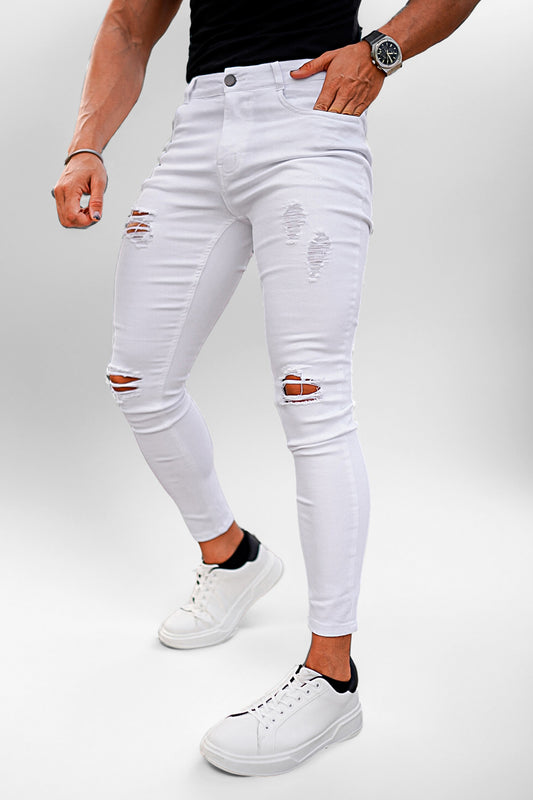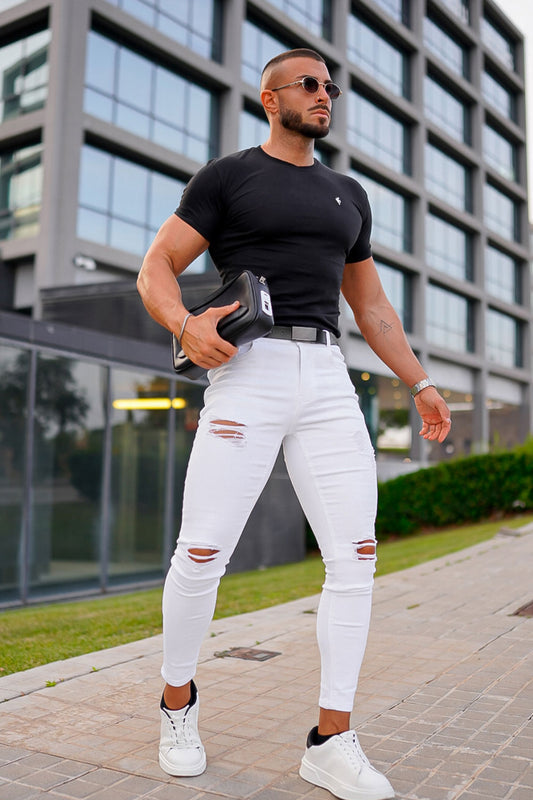How to Make Jeans Look More Vintage?
Jeans are a timeless wardrobe staple, but there's something particularly appealing about a well-worn, vintage pair.
The good news is that with the right techniques, you can transform a regular pair of jeans into something that looks like it has decades of history.

Understanding the Vintage Aesthetic
Vintage jeans typically exhibit certain characteristics:
-
Faded Color: A worn, faded color, especially around high-wear areas like the knees, thighs, and seat.
-
Distressed Details: Signs of wear such as frayed edges, small holes, and distressed patches.
-
Softened Fabric: The fabric is usually softer and more pliable, indicating years of wear.
-
Whiskering and Honeycombs: Faded lines and creases that form naturally over time, typically around the crotch area and behind the knees.
1. Choosing the Right Jeans
Before you start transforming your jeans, it’s important to choose the right pair as a base. Consider the following factors:
1.1. Fabric Quality and Weight
Vintage jeans typically have a heavier weight and are made from high-quality denim.
Look for jeans that are 100% cotton, as these will wear and age more authentically than jeans with a significant stretch content.
1.2. Wash and Color
Opt for jeans that are a solid, medium-to-dark indigo. Lighter washes and pre-distressed jeans might not give you the desired vintage look when you try to distress them further.
1.3. Fit
Classic vintage jeans often feature a straight-leg or slightly tapered fit. Skinny or overly relaxed fits might not convey the same vintage vibe. Choose a fit that suits your style but leans towards a traditional cut.
2. Washing Techniques for a Vintage Look
Washing your jeans in specific ways can help soften the fabric and create a faded, worn-in look over time.
2.1. Cold Water Wash
Washing jeans in cold water slows down the fading process but will soften the fabric.
Add a small amount of mild detergent and let your jeans soak for 30 minutes before rinsing.
This process will gradually lighten the fabric without overly stressing it.
2.2. Vinegar and Salt Soak
A vinegar and salt soak can help set the dye while also softening the denim.
Mix one cup of white vinegar and half a cup of salt in a bucket of cold water.
Soak your jeans for a couple of hours, then air dry them. This method gives your jeans a subtle, natural fade.
2.3. Sandpaper Wash
For a more distressed look, lightly rub fine-grit sandpaper over areas that would naturally wear, such as the thighs, knees, and back pockets.
After sanding, wash your jeans in cold water to remove any excess dye and fabric particles.
3. Distressing Techniques
Distressing adds character and a lived-in appearance to jeans. Here are some techniques to achieve this effect:
3.1. Ripping and Fraying
To create authentic-looking rips and frays, use a pair of scissors or a razor blade to make small cuts in the fabric. Focus on areas like the knees, pockets, and hem.
Once you’ve made the cuts, use sandpaper or a pumice stone to fray the edges, giving the rips a natural, worn look.
3.2. Whiskering
Whiskering refers to the faded lines that appear around the crotch and upper thighs of well-worn jeans.
To replicate this effect, use sandpaper or a fine wire brush to lightly rub these areas in a horizontal motion. Be sure to apply even pressure and blend the edges for a realistic finish.
3.3. Bleaching
Bleaching is a powerful way to fade and distress jeans quickly.
Dilute bleach with water in a spray bottle and apply it to your jeans, focusing on areas you want to lighten, such as the thighs and knees.
Let the bleach sit for a few minutes, then rinse the jeans thoroughly in cold water. Be cautious with this method, as too much bleach can weaken the fabric.
4. Adding Patina and Fading
Patina and natural fading are key elements of the vintage look. These can be achieved with time, or you can expedite the process with some creative techniques.
4.1. Sun Fading
Hanging your jeans in direct sunlight for extended periods can help fade the fabric naturally. Rotate the jeans every few hours to ensure even fading. This method is slow but creates a beautifully authentic vintage fade.
4.2. Tea Staining
For a subtle, aged effect, soak your jeans in a strong tea solution. Brew several tea bags in boiling water and let the tea cool.
Soak your jeans for several hours, then rinse them in cold water. The tea will leave a slight tint, giving the denim a warm, vintage hue.
4.3. Tumble Drying with Tennis Balls
To add softness and a bit of wear to your jeans, toss them in the dryer with a couple of tennis balls.
The balls will pound the fabric, creating a broken-in feel. Use a low heat setting to avoid excessive shrinkage or damage.
5. Personalizing Your Vintage Jeans
Adding personal touches to your jeans can make them truly unique and enhance their vintage appeal.
5.1. Patches and Repairs
Vintage jeans often have visible repairs or patches that add to their character.
Sew on patches in contrasting colors or fabrics, or use visible mending techniques to repair small rips and tears.
This not only extends the life of your jeans but also adds to their charm.
5.2. Painting and Embroidery
For a custom vintage look, consider adding hand-painted designs or embroidery.
Simple patterns, initials, or symbols can be painted on using fabric paint, or embroidered with needle and thread.
These personal touches can make your jeans stand out and tell a story.
Conclusion
Achieving a vintage look for your jeans is a fun and creative process that allows you to personalize your denim.
Whether you’re fading, distressing, or adding unique touches, each step brings you closer to a pair of jeans that feels uniquely yours.
With the right techniques and a little patience, you can transform any pair of jeans into a timeless piece that tells its own story.










